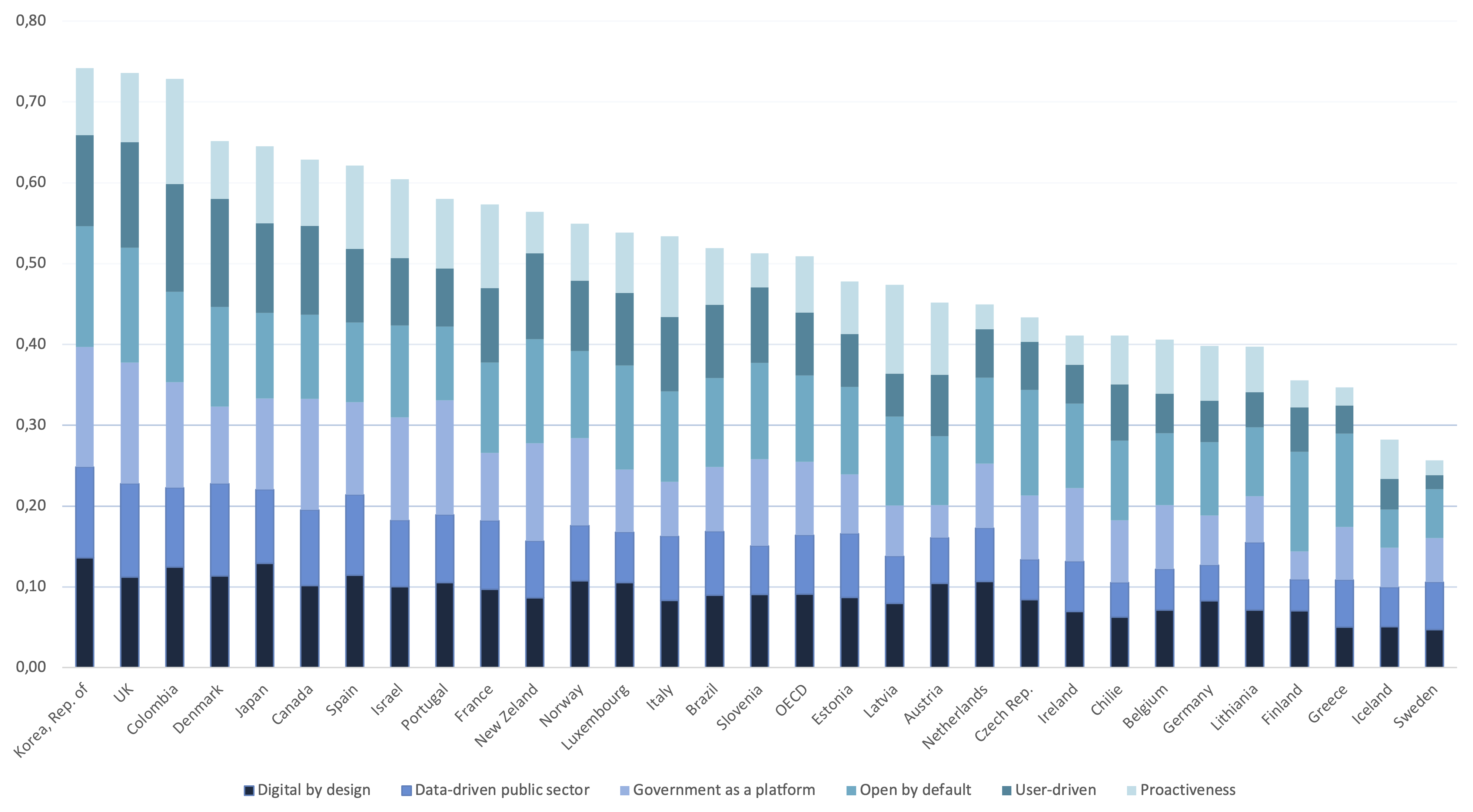Data Analysis Technologies

With the rapid development of government information systems, the volume of unique data is growing.
By strengthening the information and analytical component, data analysis and big data technologies increase the effectiveness of decision-making, especially in terms of health, employment, economic regulation, crime control, and data-driven decision management.
An increasing number of states believe include data into the list of strategic resources, which can be used for public policy objectives.
According to OECDs’ Digital Government Development Index, the global leaders in data-based government are Republic of Korea, the UK and Colombia.

Source: OECD, Digital Government Development Index
Given the growing interest of government bodies in the use of big data, the importance of conducting an appropriate audit increases. According to sector studies[1], big data audits include three interrelated levels: technological, managerial, and strategic. Each of them is oriented towards the assessment of the following parameters:
- Effectiveness of the innovative technologies introduction to the work of a government body. The key assessment criteria are the quality of data collection, the variety of processing methods, and the development and availability of infrastructure.
- Effectiveness of organization's structure in the context of the big data use. Particular attention is paid to assessing the quality of professional training, interaction between departments on the use of big data, and the work of technological centers for processing big data.
- Correspondence between the expected and obtained results from the introduction of big data analysis technologies. The assessment criteria are the total number of identified inaccuracies in the operation of data mining algorithms (performance), the social effect of increased transparency of information (legitimacy), and the accuracy of risk management (forecasting).
[1] Appelbaum D, Kogan A, Vasarhelyi M A. Big Data and Analytics in the Modern Audit Engagement: Research Needs. Auditing A Journal of Practice & Theory, 2017, 36(4):1-27; Al-Sai Z, Abdullah R, Husin H. Critical Success Factors for Big Data: A Systematic Literature Review. IEEE Access, 2020:1-1
Data Analysis Technologies – Case Studies
Australian National Audit Office

SAI: Australian National Audit Office
Title: Using data analytics for risk-based performance audit planning
Date: October 25, 2021
Link: Proceed
As part of a survey by the Accounts Chamber of the Russian Federation with regard to the development of the INTOSAI Moscow Declaration Provisions, the Australian National Audit Office prepared an overview of the use of data analysis technologies in the audit of government grants. The analysis is based on comparing the databases of conducted tenders and concluded contracts, along with the grounds for concluding state contracts (whether the contract was concluded as a result of a multi-stage standard evaluation procedure or outside of it). This has helped to identify cases where contracts were awarded prior to the formal closing of the tender, which in turn allows for the identification of high-risk contracts.
The Australian National Audit Office believes that the use of data analysis elements in the audit activities makes it possible to:
- identify the riskiest projects within all government expenditures;
- identify cases that require closer examination in the course of further audit activities;
- identify conditions that lead to irregularities in tenders;
adjust the audit program at the SAI level in a timely manner.
National Audit Office of China

SAI: National Audit Office of China
Title: Audit Data Analysis in the Big Data Era
Date: September 15, 2021
Link: Proceed
The National Audit Office of China has systematized the experience of using data analysis technologies and working with big data during audits. Auditors confirm that the use of a variety of data analysis tools to form audit opinions has become a common practice not only within the SAI itself, but also within regional control offices. In addition, it is confirmed that, while developing state programs and projects, public authorities actively involve technologies and specialists oriented towards data analysis and work with big data. Data management, however, often uses the simplest and most basic tools (such as Excel), while the use of programming languages and specialized solutions remains a rare practice. In addition, work with data is complicated by the lack of a unified data register and the possibility of prompt exchange of information, including that of a restricted nature.
Auditor General Office of Denmark

SAI: Auditor General Office of Denmark
Title: Report on open data
Date: March 15, 2019
Link: Proceed
Access to government data is a key indicator of how transparent the State is. It also helps to ensure economic growth and development. In 2019, the SAI of Denmark investigated the publishing of open government data on the Internet. According to the auditors, the lack of consistency in data sets publication (the data are scattered across 88 sources), as well as the problem with determining the authority responsible for the publication of government data, impede the transparency of the public authorities activities.
The SAI of Denmark highlights a number of follow-up recommendations in terms of open data:
- responsibilities for the publication of open data should be clearly defined and distinguished between agencies;
- when selecting data for public access, the principle of “default transparency” must be observed, i.e. all agencies are obliged to make the data publicly available if there is no good reason not to do so;
expansion and regular updating of the open data directory is required.
Auditor General Office of Denmark

SAI: Auditor General Office of Denmark
Title: The "Moscow Declaration Provisions through SAIs' Perspective" Course
Date: September 15, 2021
Link: Proceed
As part of the "Moscow Declaration Provisions through SAIs' Perspective" course[1], the SAI of Denmark prepared in 2021 the "Data analytics in audit" speech. As an example of working with digital sources, a check by the Danish tax office was cited. The SAI used STATA statistical analysis software to work with a large set of data. This approach has led to a better understanding of the size of the Danish Government's debt, the principal debtors, and how to manage the debt effectively.
[1]The course is presented on the digital platform of the University for the INTOSAI Community, www.u-intosai.org
UK National Audit Office

SAI: UK National Audit Office
Title: Using data analytics for risk-based performance audit planning
Date: June 21, 2019
Link: Proceed
The UK government is actively using data to improve both policies in various areas, as well as to improve the quality of public administration and provide better services to the citizens of the country. At the same time, there are a number of serious challenges related primarily to the issues of safe use and storage of data (including personal data of citizens), as well as finding a balance of interests of stakeholders related to working with data in order to ensure sustainable and effective investment of public funds in working with data.
The UK NAO believes that further development of the use of data at the government level requires a coherent strategy for collecting, sorting, storage and use of personal data of citizens by government agencies. A special role in this matter is played by the widest possible coverage of departments in order to exclude duplication of functions, powers, and requests.
UK National Audit Office

SAI: UK National Audit Office
Title: Improving government data: A guide for senior leaders
Date: July 21, 2022
Link: Proceed
The UK NAO has developed a guidance on data management in the public sector. The SAI noted that data is one of the most important assets of the government and it is vital to foster exchange, improve quality, develop appropriate standards, and form inter-agency data sets. The guide deals with the management of data that is collected for the effective delivery of public services. At the same time, NAO emphasizes that the document can also be useful for managing data for policy making. The document is intended to promote the activities of the management of state bodies: accountants, directors, as well as persons responsible for the provision of public services.


